
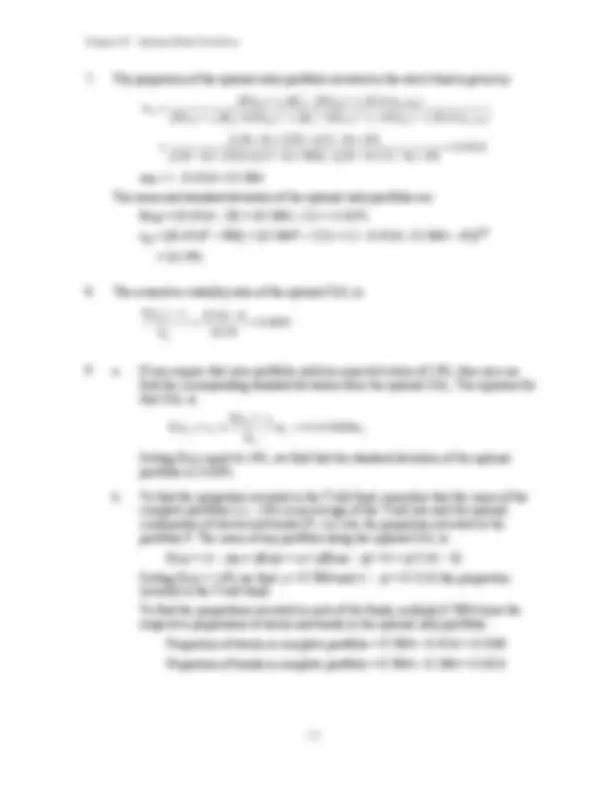
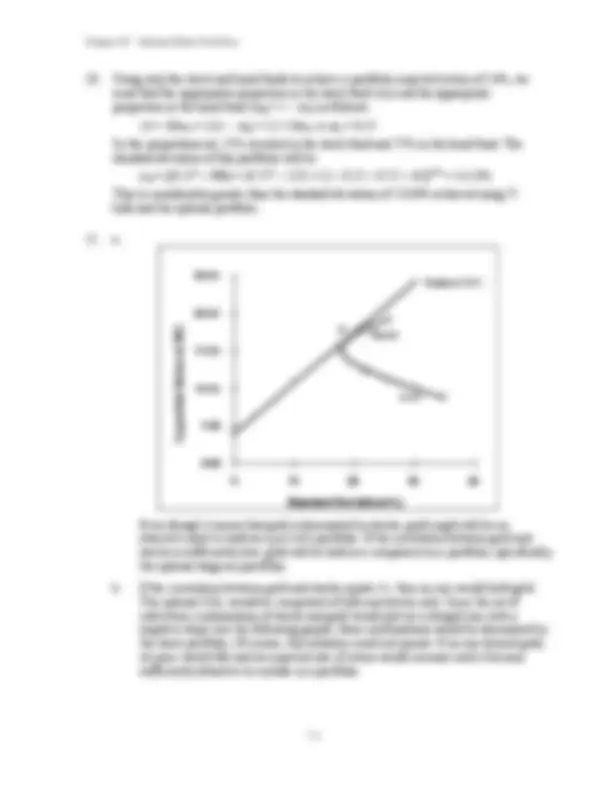
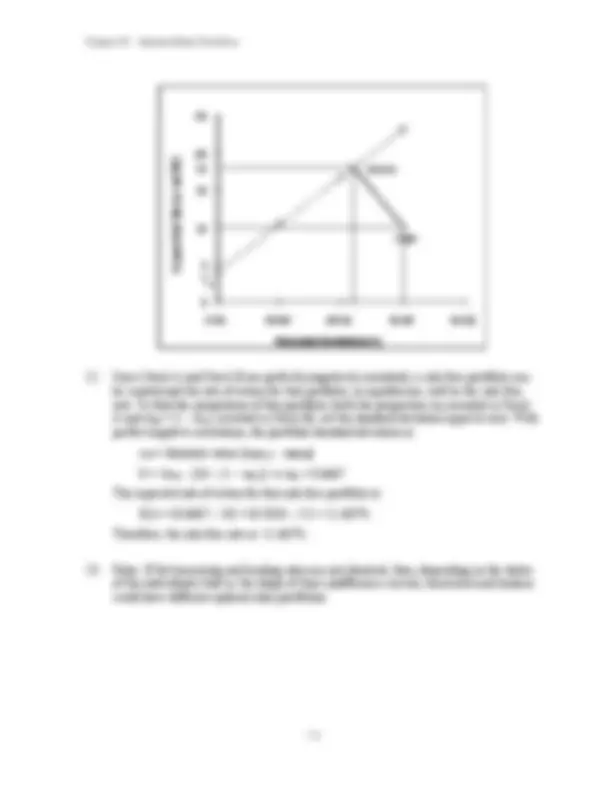
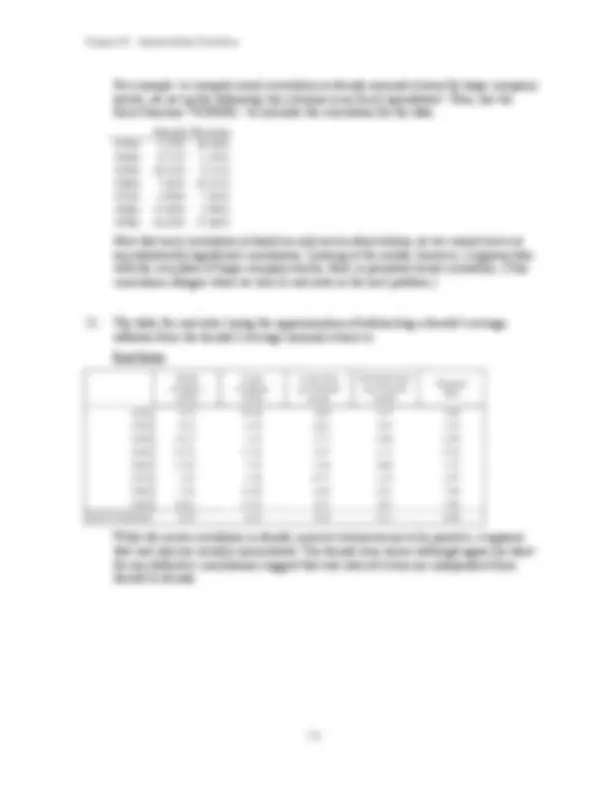
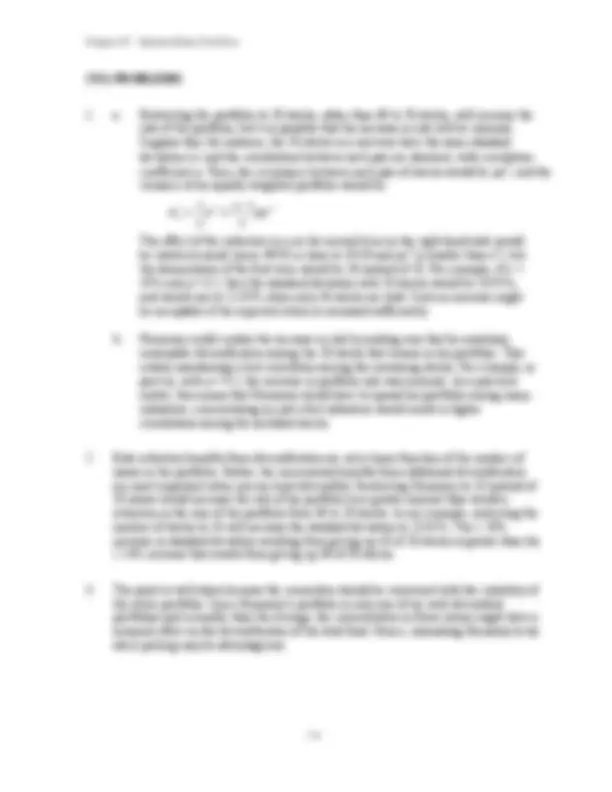
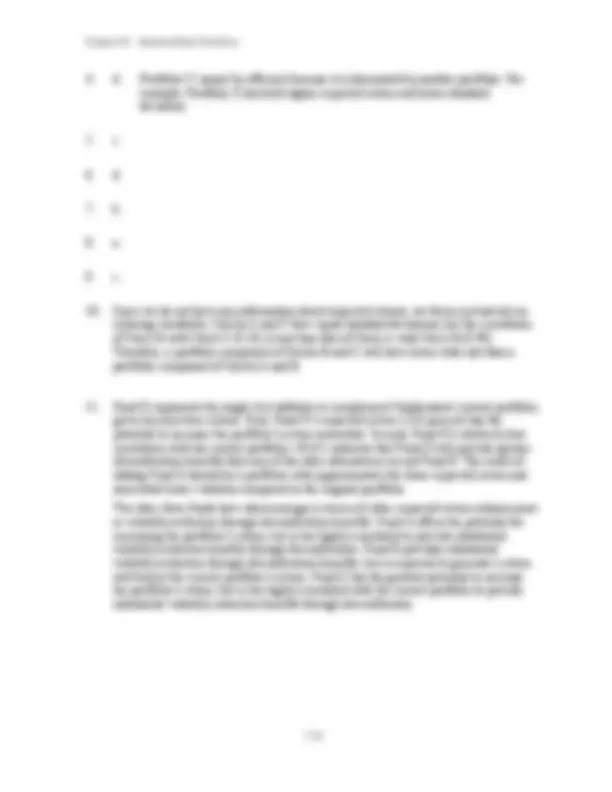


Study with the several resources on Docsity

Earn points by helping other students or get them with a premium plan


Prepare for your exams
Study with the several resources on Docsity

Earn points to download
Earn points by helping other students or get them with a premium plan
Community
Ask the community for help and clear up your study doubts
Discover the best universities in your country according to Docsity users
Free resources
Download our free guides on studying techniques, anxiety management strategies, and thesis advice from Docsity tutors
(a) and (c). After real estate is added to the portfolio, there are four asset classes in the portfolio: stocks, bonds, cash and real estate.
Typology: Lecture notes
1 / 12

This page cannot be seen from the preview
Don't miss anything!







E(rS) = 20%, E(rB) = 12%, S = 30%, B = 15%, From the standard deviations and the correlation coefficient we generate the covariance matrix [note that Cov(rS, rB) = SB]: Bonds Stocks Bonds 225 45 Stocks 45 900 The minimum-variance portfolio is computed as follows:
wMin(S) = 0. 1739 900 225 ( 2 45 )
2 Cov(r,r )
Cov(r,r ) S B
2 B
2 S
S B
2 B (^)
wMin(B) = 1 0.1739 = 0. The minimum variance portfolio mean and standard deviation are: E(rMin) = (0.1739 20) + (0.8261 12) 13.39% Min =[w (^2) S S^2 w^2 B^2 B 2 wSwBCov(rS,rB)]^1 /^2
= [(0.1739^2 900) + (0.8261^2 225) + (2 0.1739 0.8261 45)]1/ = 13.92%
Proportion in stock fund
Proportion in bond fund
Expected return
Standard Deviation 0.00% 100.00% 12.00% 15.00% 17.39% 82.61% 13.39% 13.92% minimum variance 20.00% 80.00% 13.60% 13.94% 40.00% 60.00% 15.20% 15.70% 45.16% 54.84% 15.61% 16.54% tangency portfolio 60.00% 40.00% 16.80% 19.53% 80.00% 20.00% 18.40% 24.48% 100.00% 0.00% 20.00% 30.00% Graph shown below.
The graph indicates that the optimal portfolio is the tangency portfolio with expected return approximately 15.6% and standard deviation approximately 16.5%.
Even though it seems that gold is dominated by stocks, gold might still be an attractive asset to hold as a part of a portfolio. If the correlation between gold and stocks is sufficiently low, gold will be held as a component in a portfolio, specifically, the optimal tangency portfolio.
b. If the correlation between gold and stocks equals +1, then no one would hold gold. The optimal CAL would be comprised of bills and stocks only. Since the set of risk/return combinations of stocks and gold would plot as a straight line with a negative slope (see the following graph), these combinations would be dominated by the stock portfolio. Of course, this situation could not persist. If no one desired gold, its price would fall and its expected rate of return would increase until it became sufficiently attractive to include in a portfolio.
Since Stock A and Stock B are perfectly negatively correlated, a risk-free portfolio can be created and the rate of return for this portfolio, in equilibrium, will be the risk-free rate. To find the proportions of this portfolio [with the proportion wA invested in Stock A and wB = (1 – wA ) invested in Stock B], set the standard deviation equal to zero. With perfect negative correlation, the portfolio standard deviation is: P = Absolute value [wAA wBB] 0 = 5wA [10 (1 – wA )] wA = 0. The expected rate of return for this risk-free portfolio is: E(r) = (0.6667 10) + (0.3333 15) = 11.667% Therefore, the risk-free rate is: 11.667%
False. If the borrowing and lending rates are not identical, then, depending on the tastes of the individuals (that is, the shape of their indifference curves), borrowers and lenders could have different optimal risky portfolios.
Since all standard deviations are equal to 20%: Cov(rI , rJ) = IJ = 400 and wMin(I) = wMin(J) = 0. This intuitive result is an implication of a property of any efficient frontier, namely, that the covariances of the global minimum variance portfolio with all other assets on the frontier are identical and equal to its own variance. (Otherwise, additional diversification would further reduce the variance.) In this case, the standard deviation of G(I, J) reduces to: Min(G) = [200(1 + I J)]1/ This leads to the intuitive result that the desired addition would be the stock with the lowest correlation with Stock A, which is Stock D. The optimal portfolio is equally invested in Stock A and Stock D, and the standard deviation is 17.03%.
Large company stocks
Long-term government bonds
Intermed-term government bonds
Treasury bills Inflation 1920s - 3.72 18.36 3.98 3.77 3.56 - 1. 1930s 7.28 - 1.25 4.60 3.91 0.30 - 2. 1940s 20.63 9.11 3.59 1.70 0.37 5. 1950s 19.01 19.41 0.25 1.11 1.87 2. 1960s 13.72 7.84 1.14 3.41 3.89 2. 1970s 8.75 5.90 6.63 6.11 6.29 7. 1980s 12.46 17.60 11.50 12.01 9.00 5. 1990s 13.84 18.20 8.60 7.74 5.02 2. Serial Correlation 0.46 - 0.22 0.60 0.59 0.63 0.
For example: to compute serial correlation in decade nominal returns for large-company stocks, we set up the following two columns in an Excel spreadsheet. Then, use the Excel function “CORREL” to calculate the correlation for the data. Decade Previous 1930s - 1.25% 18.36% 1940s 9.11% - 1.25% 1950s 19.41% 9.11% 1960s 7.84% 19.41% 1970s 5.90% 7.84% 1980s 17.60% 5.90% 1990s 18.20% 17.60% Note that each correlation is based on only seven observations, so we cannot arrive at any statistically significant conclusions. Looking at the results, however, it appears that, with the exception of large-company stocks, there is persistent serial correlation. (This conclusion changes when we turn to real rates in the next problem.)
Large company stocks
Long-term government bonds
Intermed-term government bonds
Treasury bills 1920s - 2.72 19.36 4.98 4.77 4. 1930s 9.32 0.79 6.64 5.95 2. 1940s 15.27 3.75 - 1.77 - 3.66 - 4. 1950s 16.79 17.19 - 1.97 - 1.11 - 0. 1960s 11.20 5.32 - 1.38 0.89 1. 1970s 1.39 - 1.46 - 0.73 - 1.25 - 1. 1980s 7.36 12.50 6.40 6.91 3. 1990s 10.91 15.27 5.67 4.81 2. Serial Correlation 0 .29 - 0.27 0.38 0.11 0. While the serial correlation in decade nominal returns seems to be positive, it appears that real rates are serially uncorrelated. The decade time series (although again too short for any definitive conclusions) suggest that real rates of return are independent from decade to decade.
b. Subscript OP refers to the original portfolio, GS to government securities, and NP to the new portfolio. i. E(rNP) = wOP E(rOP ) + wGS E(rGS ) = (0.9 0.67) + (0.1 0.042) = 0.645% ii. Cov = r OP GS = 0 2.37 0 = 0 iii. NP = [wOP^2 OP^2 + wGS^2 GS^2 + 2 wOP wGS (CovOP , GS)]1/ = [(0.9 2 2.37^2 ) + (0.1^2 0) + (2 0.9 0.1 0)]1/ = 2.133% 2.13%
c. Adding the risk-free government securities would result in a lower beta for the new portfolio. The new portfolio beta will be a weighted average of the individual security betas in the portfolio; the presence of the risk-free securities would lower that weighted average.
d. The comment is not correct. Although the respective standard deviations and expected returns for the two securities under consideration are equal, the covariances between each security and the original portfolio are unknown, making it impossible to draw the conclusion stated. For instance, if the covariances are different, selecting one security over the other may result in a lower standard deviation for the portfolio as a whole. In such a case, that security would be the preferred investment, assuming all other factors are equal.
e. i. Grace clearly expressed the sentiment that the risk of loss was more important to her than the opportunity for return. Using variance (or standard deviation) as a measure of risk in her case has a serious limitation because standard deviation does not distinguish between positive and negative price movements.